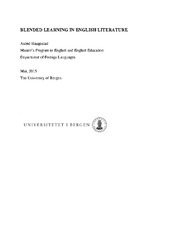Blended Learning in English Literature
Abstract
Abstract Blended Learning This study investigates blended learning used in a course of English Literature and Culture in upper secondary school. It raises the question how the use of blended learning may promote and encourage learning in a course of English literature and culture. The study also compares traditional face-to-face classroom communication with communication mediated by digital artefacts. It has been important to go beyond the strictly technical issues and explore how the digital world can be brought closer to the classroom and enhance learning in a blended working atmosphere. An important source of inspiration has been to see how the digital life world of the students can be brought closer to the educational world. After more than twenty years as a teacher trying to make use of digital technologies I have developed an increasing interest in investigating how digital artefacts actually affect the processes of teaching and learning. The use of blended learning raises several questions. These questions pay attention to some closer aspects of digital learning compared to face-to- face learning in a blended working atmosphere. The analyses and discussion in this study have been centred on the following research questions: 1.How digital methods may benefit students in a blended classroom 2. How the use of digital methods seems to influence the learning outcome compared to the use of non-digital methods 3. How digital communication in the classroom may change and affect teaching and learning 4. The role of the teacher in a blended classroom Online discussions, digital bulletin boards and multimedia tools were used both in and outside the classroom to engage the students in digital activities combined with traditional teaching. A clear majority of the students seemed to favour the use of blended learning. This was the main result from both surveys and interviews. All students claimed that traditional face-to-face learning was still important for their learning outcomes. Findings indicate that digital methods, although well functioning, are not equivalent and can not exchange non-digital methods in all fields of learning. Findings also indicate that an active teacher presence is important in a blended working classroom. In this study blended learning has been examined in a sociocultural perspective, related to the zones of proximal development. It shows that students increase their learning and knowledge by taking part in digital activities where they over time relate and collaborate. In this blended classroom language and digital artefacts seem to function as structural resources.
